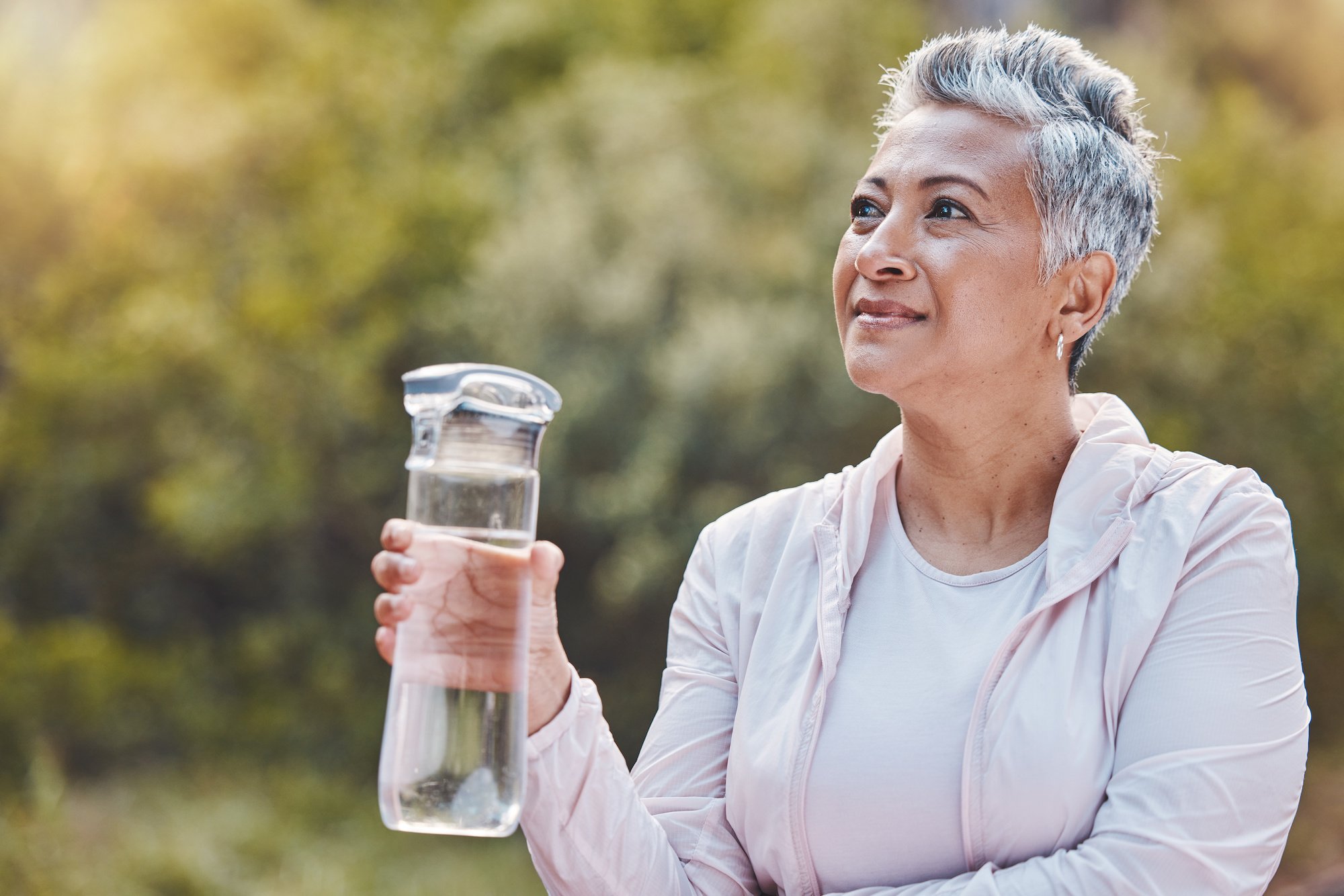
What’s one of the simplest things you can do to protect your kidneys, heart, circulation, skin and just about every system in your body? Drink more water.
Unfortunately, as many as 40% of seniors do not consume enough fluids, and about 17-28% of older adults are chronically dehydrated. Dehydration can leave you feeling unwell and exacerbate underlying health conditions. It can also increase your risk of heat exhaustion and serious medical issues like blood clots.
So what are some signs that you might be chronically dehydrated? Look for these symptoms:
-
Dark urine, as clearer urine means you’re better hydrated.
-
Kidney issues, such as kidney stones.
-
Skin that feels dry, itchy or flaky.
-
Frequent unexplained headaches, especially in the heat or after exercising.
-
Unexplained fatigue.
-
Chronic or sudden constipation.
-
Trouble concentrating or paying attention.
-
A dry mouth or throat.
The good news is that — unless you have chronic kidney disease or a doctor has told you to limit fluids — there’s no risk associated with drinking more water. And hydration for seniors doesn’t have to be complicated! It’s a simple matter of drinking more fluids than your body uses each day.
Benefits of Drinking More Water
You’ve probably heard that most of your body is water, so when you’re running low on this vital ingredient, virtually every bodily system tends to function less effectively. Here are some crucial benefits of drinking water:
-
It helps lubricate the joints.
-
It helps make saliva so your mouth and throat don’t feel dry or irritated.
-
Hydrated skin looks better and is less vulnerable to certain skin conditions.
-
It helps your digestive system function, reducing constipation and helping you become more regular.
-
It helps your blood maintain appropriate consistency, making it easier to attain healthy blood pressure.
-
It may help you perform better when exercising.
-
It could help you eat healthier, especially if you replace sugary drinks with water.
7 Tips for Hydration for Seniors
Staying more hydrated is a habit, and like any other habit, it takes time to develop. These seven strategies for hydration for seniors can help you integrate water into your routine, and make drinking more water more enjoyable.
1. Choose Water You Like
Drinking water isn’t exactly a flavorful experience. If you’re accustomed to juices or soda, switching to more water can feel bland. The best option will always be pure water, but finding ways to make water more palatable can help you access many of the same benefits. Try the following:
-
Flavor your water with a bit of lemon or lime.
-
Try filtered or distilled water. Some people notice minerals in tap water and dislike the taste.
-
Consider seltzer water, which offers the same bubbly texture as soda without the calories and sugar.
-
If these options don’t work, consider using a water-flavoring packet. This adds some sugar and calories to water, but not as much as you would get from soda or juice.
2. Make Drinking Water Easy
Drinking water is like any other habit, meaning it takes time to become a part of your daily routine. It’s easier to make hydration a habit when water is always readily available. No one wants to run across the house to grab a water bottle when they’re in the middle of something. And if you’re enjoying a chat with a friend, getting some water might be the last thing on your mind. Try these tips:
-
If you like filtered or distilled water, consider getting a water filter or water cooler so you always have easy access to water.
-
Invest in a few reusable water bottles you like. There’s no shame in picking something stylish if it increases the likelihood you’ll use it!
-
Stash water bottles in places you’re likely to use them. Put one in your bag, another in your bedroom or home office and another in the kitchen. Keep one in your car, but avoid storing plastic bottles in hot cars for long periods. A disposable paper water bottle or reusable metal water bottle are safer picks.
-
Partner up! Friendships make us healthier, especially when you can share health goals. Ask a friend if they want to be your hydration accountability buddy or compete to see who can hit their hydration goals faster.
-
Consider a water tracking app. Smart water bottles do all the work for you, and can provide you with data over time, too. Check out The Hydromate Smart Water Bottle, or the Hidrate Spark Pro Smart Water Bottle.
3. Schedule Water Breaks
Some people simply don’t feel thirsty much. Others are so accustomed to feeling chronically dehydrated that they’ve learned to ignore the signs that they need water. Make water breaks a part of your schedule. Try setting your watch for an hourly water break, and always drink water with meals or snacks.
It can also be helpful to use cues as a reminder to drink water. Try:
-
Grabbing a sip of water every time you use the bathroom.
-
Taking a water break every time you come home from an errand or go outside.
-
Putting water on your bedside table and drinking a glass when you wake up.
4. Get More Fluid From Foods
Foods are an important source of hydration. In fact, about 20% of your daily fluid intake comes from foods. Rev up your commitment to wellness by adding more fluid-rich, heart-healthy foods to your diet. Almost all fruits and vegetables have a high water content, but some especially great choices include:
-
Watermelon
-
Apples
-
Tomatoes
-
Cucumber
-
Watercress
-
Peppers
-
Peaches
-
Strawberries
-
Blueberries
-
Raspberries
As a bonus, these foods are high in fiber, helping you maintain exceptional digestive health.
5. Know How Hydration Needs Can Change
Healthy living is all about understanding that wellness is never one-size-fits-all. You’ve probably heard you should drink eight glasses of water per day. This is a good goal, but it doesn’t tell the full story. Everyone’s fluid needs are different. Some people may need less, whereas others might need more.
Some factors that can affect fluid needs include:
-
Location: You might need more water in dry weather.
-
Time of year: You'll use more fluids in extremely cold or hot climates.
-
Exercise: Exercise causes you to sweat, increasing your body’s water demands.
-
Diet: If you drink a lot of caffeine or consume lots of salt, you may feel thirstier.
-
Digestive health: Vomiting and diarrhea use a lot of water and can quickly dehydrate you.
-
Kidney disease: Some people with chronic kidney disease, especially those on dialysis, may need to change their fluid intake.
6. Monitor Chronic Health Conditions
Although it’s generally true that more water is healthier, your consumption habits might need to change with certain health conditions. People with congestive heart failure or advanced kidney disease may need to reduce their water intake. Ask your doctor how much you need to drink daily and whether you need to take other steps to improve your health.
7. Don’t Wait Until You Feel Dehydrated
The signs of dehydration include fatigue, dry skin and lips and extreme thirst. But don’t wait for these signs to appear, or you’ll be chronically dehydrated. This makes it harder to become fully hydrated and undermines your overall health.
You deserve to feel healthy. So make water part of your daily wellness routine rather than waiting for dehydration to rear its dry, parched head.
Most of us want to stay healthy so we can enjoy time with friends and family. But did you know that friends and family are key ingredients in the recipe for good health? Learn more about how relationships can help you achieve your wellness goals.




.png?width=260&height=56&name=new-hg-logo-rev-with-registered-mark%20(2).png)